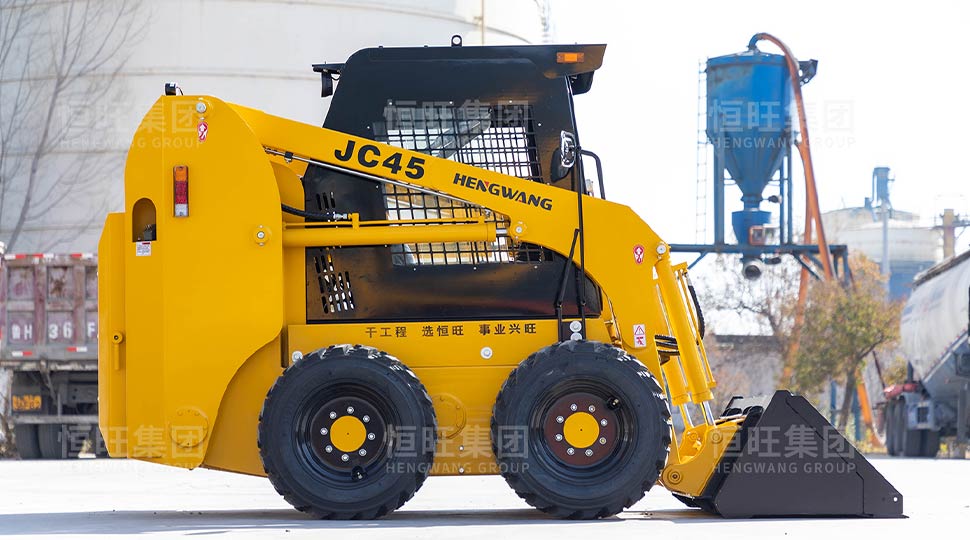In narrow scenarios such as renovation of old urban areas in Paris and redevelopment of urban villages in New York, the "passability" of construction site loader often determines construction efficiency more than "horsepower". Traditional wide-body loaders, due to their bulky bodies, often reverse repeatedly in 2-meter-wide lanes, resulting in less than 4 hours of effective daily operation; while the "short tail + small radius" design of Hengwang construction site loader can reduce turning time by 40% and increase daily handling volume by 25% in the old block project in Rome. This guide will explain: how foreign narrow construction sites can advance the construction period by 15 days by choosing the right construction site loader.
I. 3 "Efficiency Traps" in Foreign Narrow Construction Sites: Fatal Flaws of Traditional Loaders
In scenarios such as old European urban areas (lane width ≤ 3 meters) and American urban villages (dense obstacles), the "large size" of traditional loaders exposes fatal problems:
lLong turning time: Loaders with a body length exceeding 6 meters need to reverse 3 times in a 2.5-meter-wide lane, increasing the time per trip by 5 minutes, and costing 6.7 more hours for 80 trips a day;
lLow space utilization: Wide-body loaders require a 1-meter safety distance during operation, resulting in 10% of the site being unused. A construction site in Rome once delayed concrete pouring for 3 hours due to equipment jamming;
lRestrictions in low spaces: The ceiling height of basements in old European buildings is often ≤ 3 meters, and traditional loaders are prone to hitting the ceiling when lifting. A renovation project in Berlin thus lost 2,000 euros worth of building materials.
II. Breakthrough Design of "Short Tail + Small Radius": 3 Parameters Determine Adaptability in Foreign Construction Sites
Hengwang construction site loader (HW-S360, HW916, HW-JC45, etc.) are optimized for foreign narrow scenarios, with core parameters directly addressing pain points:
1.3Body length ≤ 5 meters: Working close to walls without wasting space
The overall dimensions of HW916 construction site loader are 3890×1300×1500mm (length×width×height), 2 meters shorter than traditional models. In the 1.8-meter-wide stone-paved lanes in Paris, it can drive close to the wall, within 30cm of the wall, directly unloading sand and gravel to the construction point, reducing secondary handling. Its 1300mm bucket width perfectly fits the size of European standard sandbags, with a single loading efficiency 20% higher than narrow-bucket models.

2.Minimum turning radius ≤ 2 meters: One-time U-turn in narrow lanes
The skid-steer loader HW-S360 has a wheelbase of only 850mm and a minimum turning radius of less than 1.5 meters. In the 2-meter-wide lanes of urban villages in New York, it can turn 90° at one time, saving 70% of turning time compared to traditional models. Field test in a construction site in Brooklyn: using it to transport bricks, each trip changed from "3 reverses" to "direct passage", with 30 more trips per day, and its operating weight of 900kg will not damage old roads.

3.Adjustable lifting height: No ceiling collision in low spaces
The maximum operating height of HW-JC45 construction site loader is 3980mm, and the boom lifting angle can be fine-tuned (0°-60°). When working in 3-meter-high basements in Berlin, it can precisely control the bucket height to avoid colliding with pipelines. Its unloading height of 2380mm just matches the height of temporary material piles in basements, eliminating the need for additional heightening, and shortening the single unloading time by 1 minute.

III. Field Test in Foreign Construction Sites: How Big is the Efficiency Gap?
The comparison data from an old building renovation project in Rome (lane width 2.3 meters, obstacle spacing 3 meters) is intuitive: traditional wide-body loaders need to turn 3 times per trip, with only 4 hours of effective daily operation and 120 tons of daily handling; while Hengwang HW-916 construction site loader turns once per trip, with 6.5 hours of effective daily operation and 180 tons of daily handling, without any collision with obstacles. The project manager summarized: "Choosing the right construction site loader is equivalent to having an extra piece of equipment working, and the construction period was advanced by 15 days."
IV. Selection Suggestions for Foreign Narrow Construction Sites: Choose Models by Site Width
l1-2 meter lanes: Prioritize HW-S360 skid-steer loader, with a wheelbase of 850mm for in-place steering, suitable for extremely narrow scenarios such as old European lanes and historical blocks;
l2-3 meter lanes: Recommend HW916 loader, with 1300mm body width + 3890mm length, working close to walls without wasting space, suitable for North American urban villages;
l3-4 meter lanes: Optional HW-JC45 skid-steer loader, with 3980mm maximum operating height + adjustable lifting angle, adapting to low basements and warehouse renovations.
Get for free: Foreign Narrow Space Loader Selection Checklist
Want to know which construction site loader is suitable for your construction site (such as old urban areas in Paris / urban villages in New York)? Fill in the company name + project leader information to get for free:
lA selection list including "lane width - model matching" and "obstacle spacing calculation";
lField test videos of Hengwang construction site loader in Rome and Berlin construction sites;
lContact information of local service outlets in Europe and North America (supporting free test operation).
In foreign narrow construction sites, "being able to enter, turn around, and avoid collisions" is more important than "high horsepower". Every design of Hengwang construction site loader is only to help you gain an extra efficiency dividend in the inch-by-inch valuable site.
